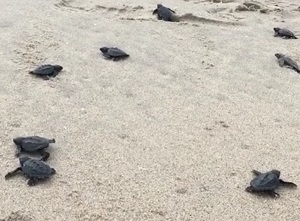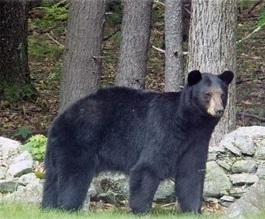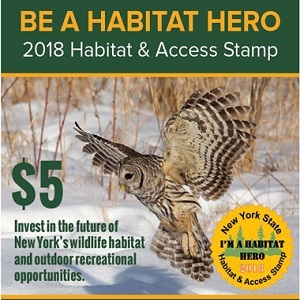Wildlife, Fish & Marine Life Newsletter
The New York State Department of Environmental Conservation sent this bulletin on 10/22/2018 11:34 AM EDT |
| DEC Delivers - Information to keep you connected and informed from the NYS Department of Environmental Conservation |
| Share or view as a web page || Update preferences or unsubscribe |
Wildlife, Fish and Marine Life Newsletter |
Endangered Kemp's Ridley Hatchlings Head Out to Sea
On July 12, beachgoers on the Rockaway Peninsula of Long Island saw a turtle crawl from the water and dig a nest. Kemp’s ridley are the second most commonly seen sea turtles in New York, yet this is the first recorded case of the turtles nesting and depositing eggs in the state. However, juveniles (2 to 5 years old) can be found as far north as Nova Scotia. Staff from the National Park Service uncovered and relocated the nest to incubate the eggs and keep them safe. Earlier this month, the eggs hatched and 96 Kemp’s ridley sea turtle hatchlings ventured out into the ocean. Adult female sea turtles often return to the same beach to lay their own eggs. DEC Stocks Lake Sturgeon into Upstate Waters
Lake sturgeon (Acipenser fulvescens) were once abundant in the Great Lakes, Lake Champlain, and adjacent watersheds. Their populations have declined due to overharvest, declining water quality, and dams placement that restricted movement to spawning grounds. Efforts to clean up Great Lakes waters have been successful to date, and sturgeon populations are now on the rise. Statewide Survey of NY Landowners About Black Bears is Underway
The questionnaire asks about positive and negative experiences people have had with bears, their perception of population trends, and their views on the potential benefits of and detriments to living among bears. The information from this survey will be used with biological data about bear abundance and information on conflicts between people and bears. This will help set population objectives for various parts of the state. People who receive the survey are encouraged to respond. Collecting information from the public on their view of appropriate wildlife population levels and the potential impact of wildlife on people is an important part of decision-making in wildlife management. Please direct all questions about the survey to CCSS at 607-255-2828 or via e-mail. Visit DEC's website for more information about black bear management or to view the New York State Black Bear Management Plan. For questions about the black bear management program call us at 518-402-8883 or send us an e-mail. Purchase a $5 Habitat and Access Stamp to Help Improve Fish and Wildlife Habitat
The Habitat & Access Stamp was created in 2002 by legislation. All funds from the purchase of Habitat & Access Stamps are directly deposited into the DEC Habitat and Access Account. It is used for ongoing and upcoming projects aimed toward conserving habitat and increasing fish and wildlife recreational access. A $5 donation is all that is required to help invest in the future of New York's outdoor recreational opportunities! |



 DEC is partnering with the Center for Conservation Social Sciences (CCSS) at Cornell University on a survey of around 11,000 randomly-selected New York landowners to better understand public perceptions of and preferences for black bear population levels. The survey is being sent out this fall to owners of both large and small residential properties and covers both rural and urban areas.
DEC is partnering with the Center for Conservation Social Sciences (CCSS) at Cornell University on a survey of around 11,000 randomly-selected New York landowners to better understand public perceptions of and preferences for black bear population levels. The survey is being sent out this fall to owners of both large and small residential properties and covers both rural and urban areas. Consider purchasing a $5
Consider purchasing a $5